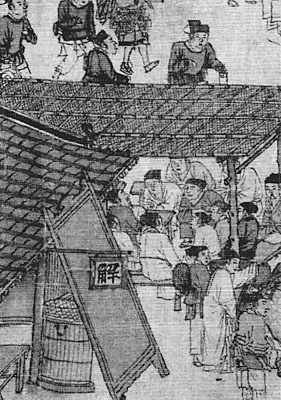History and Milieu (1)

The eternal storyteller
Whenever the children of the lanes and streets are naughty and their parents get annoyed, they hastily give them some coins and tell them to go and sit down to listen to stories about old times. When the tale of The Three Kingdoms is told, and they hear about the defeat of Liu Bei, they fret and some even shed tears. When they hear of Cao Cao's defeat, they become happy and applaud. This shows that the worthy man and the mean will both leave their mark, not to be erased in a hundred generations.
Su Dongpo (1036-1101)
Su Dongpo's famous remark on storytelling is complemented by a roughly contemporary masterpiece of art by Zhang Zeduan. His famous painted scroll from 1117, entitled ‘Spring Festival along the River’ Qingming shanghe tu, gives detailed pictures of daily life in the streets of the capital Bianjing. Right at the beginning of the long scroll one finds a storyteller’s booth under an awning at a corner of the street. The storyteller is actively entertaining a small audience of people who seem to have gathered around him while passing by. He turns his back halfways onto the onlooker of the painting, but one can see his profile, an old man with a thin beard, and the enchanted faces of his audience, standing in a halfcircle around his table. His advertises his business on a vertical tablet hanging outside his booth: ‘Explanations’. He pursues his metier in the same natural way as any other artisan in the picture: the wheelwright, the knife-grinder, the boatswain, the carrier, the innkeeper, the pedlar—the people of the ’hundred professions’. Isn't this the eternal Chinese storyteller coming to life before our eyes?